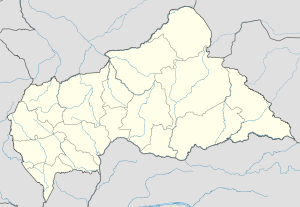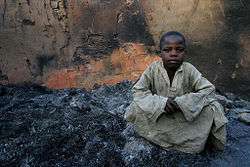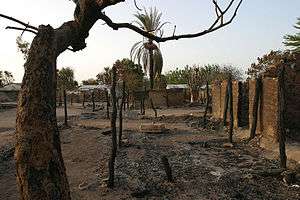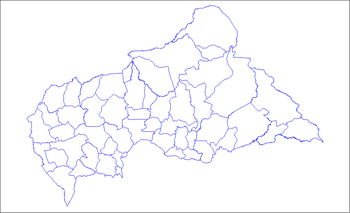Birao
| Birao | |
|---|---|
|
Burned down Birao | |
 Birao Map of the Central African Republic | |
| Coordinates: 10°17′38″N 22°46′55″E / 10.294°N 22.782°ECoordinates: 10°17′38″N 22°46′55″E / 10.294°N 22.782°E | |
| Country |
|
| Prefecture | Vakaga |
| Elevation | 468 m (1,536 ft) |
| Population (2012) | |
| • Total | 10,178 |

Birao is the capital of Vakaga, one of the 14 prefectures of the Central African Republic and was an administrative post in the colony of Ubangui-Shari.[1] In March 2007, the town was almost completely burnt down in the fighting between rebels and government troops in the area. As of December 1, 2010, Birao was controlled by the army of Chad, on behalf of the government of the Central African Republic.[2]
History
Under Bokassa
Jean-Bédel Bokassa, the military ruler of the Central African Republic in the 1960s and 1970s, sent the family of Alexandre Banza to Birao after Banza attempted to overthrow him. Birao was isolated from the rest of the country and Banza's family was monitored by Bokassa. Banza's wife and nine children were kept in Birao until 1970. Beouane and Goboulo, Banza's two brothers, were also kept in Birao, but were soon imprisoned.[3]
Birao was considered an undesirable place to be sent; the "disciplinary cells" in the Ngarabga Prison run by Bokassa were called Birao.[4] Later, after Bokassa had fallen from power and his execution sentence had been commuted, sending Bokassa to Birao was considered a possibility because the remote location of the place would separate him from his political allies.[5]
Central African Republic Bush War
In November 2004, at least 20 people were killed in a raid on the remote town of Birao in the north-east of the Central African Republic.[6]
2006
On October 29, 2006, a force of around 150 rebels took the town of Birao, which is close to the border with Sudan and Chad. The rebels from the UFDR movement say some government troops joined them, and others were taken prisoner. The CAR government accused Sudan of being behind that attack.[7]
On November 14, France, the traditional backer of the CAR government, offered the CAR military assistance in the form of logistics and aerial reconnaissance. France already has a regular 200-soldier contingent in the CAR whose strength is comparable to the CAR's ill-equipped 5,000-soldier army.[8] On that day, the UFDR announced that they had suspended military activities in favour of negotiations.[9]
On November 17, Chad's parliament approved troop deployment to the CAR.[10] The CAR government appealed to the United Nations to send troops,[11] and United Nations Secretary-General Kofi Annan called for the attacks in CAR's border with Darfur to end.[12] Chad's decision to deploy troops to the CAR came as hopes for deal with Sudan over peacekeeping forces in Darfur proved premature.[13][14]
On December 14, France admitted having performed air raids against UFDR positions since the beginning of December, employing Mirage F1 fighters and helicopter gunships, and including an attack on the UFDR-controlled town of Birao. French Defence Ministry spokesman said the action was "in line with international calls to stabilise the region". UFDR reports claim that the raids had a devastating effect on civilian population.[15]
2007

On April 13, 2007, a peace agreement between the government and the UFDR was signed in Birao. The agreement provides for an amnesty for the UFDR, its recognition as a political party, and the integration of its fighters into the army.[16]
In March 2007, the Union of Democratic Forces for Unity attacked the French army and the armed forces of the Central African Republic (FACA), which held Birao at the time.[17] Students who used to attend the secondary school in Birao were in the UFDR forces.[17]
Recent fighting
On November 15, 2010, United Nations forces returned control of Birao to the government of the Central African Republic.[2] Later in November, a rebel group called the Convention of Patriots for Justice and Peace captured Birao.[2] On December 1, 2010, Birao was captured by the army of Chad, on behalf of the government of the Central African Republic.
Notes
- ↑ Kalck pg.24
- 1 2 3 Thurston, Alex. "Renewed Violence Prompts Concern in Central African Republic." Africa Monitor. The Christian Science Monitor, 3 Dec. 2010. Web. 10 Dec. 2010. <http://www.csmonitor.com/World/Africa/Africa-Monitor/2010/1203/Renewed-violence-prompts-concern-in-Central-African-Republic>.
- ↑ Titley, pg. 34
- ↑ Titley, pg. 37
- ↑ Titley, pg. 203
- ↑ "Raid on CAR town 'leaves 20 dead'". BBC. 2004-11-23. Retrieved 2016-04-12.
- ↑ "CAR rebels seize town near Chad". BBC. 2006-10-30. Retrieved 2016-04-12.
- ↑ "France renders last minute support to Central African Republic", Afrol News, November 14, 2006
- ↑ "CAR rebels make fresh call for talk", Independent Online, November 14, 2006
- ↑ "Chadian parliament votes in favor of troop deployment to Central African Republic", November 17, 2006
- ↑ "Central Africa's Bozize asks EU to push for UN troops", Reuters, November 17, 2006
- ↑ "Annan Urges End to Attacks Near Central African Republic's Border", United Nations, November 11, 2006
- ↑ "US Rice hopes Sudan will okay Darfur force", Sudan Tribune, November 17, 2006
- ↑ "Sudan 'did not' give ok over international force for Darfur - top official", Kuwait News Agency, November 17, 2006
- ↑ "France admits air raids on Darfur neighbours" Archived July 24, 2008, at the Wayback Machine., The Independent, 15 December 2006
- ↑ "Central African Republic, rebels sign peace deal", Associated Press (USA Today), April 13, 2007.
- 1 2 Report of the Committee of Experts on the Application of Conventions and Recommendations: (articles 19, 22 and 35 of the Constitution) : Third Item on the Agenda : Information and Reports on the Application of Conventions and Recommendations. Rep. no. 3 (Part 1A). Geneva: International Labour Conference, 99th Session, 2010. International Labour Office. Web. 8 Dec. 2010. pg. 219 <https://books.google.com/books?id=mKQYAP67eh8C&dq=Birao&source=gbs_navlinks_s>
References
- Kalck, Pierre. Historical Dictionary of the Central African Republic. Lanham, MD: Scarecrow, 2005.Google Books. Google. Web. 8 Dec. 2010. <https://books.google.com/books?id=tbDFlvQeps0C&pg=PA24&dq=Birao&hl=en&ei=YiYATfW-I8einQe18PHlDQ&sa=X&oi=book_result&ct=result&resnum=5&ved=0CDwQ6AEwBDgU#v=onepage&q=Birao&f=false>.
- Titley, E. Brian. Dark Age: the Political Odyssey of Emperor Bokassa. Montreal: McGill-Queen's UP, 1997. Google Books. Google. Web. 8 Dec. 2010. <https://books.google.com/books?id=kEPbRmivj7IC&pg=PA43&dq=Birao&hl=en&ei=YiYATfW-I8einQe18PHlDQ&sa=X&oi=book_result&ct=result&resnum=6&ved=0CEEQ6AEwBTgU#v=onepage&q=Birao&f=false>.

